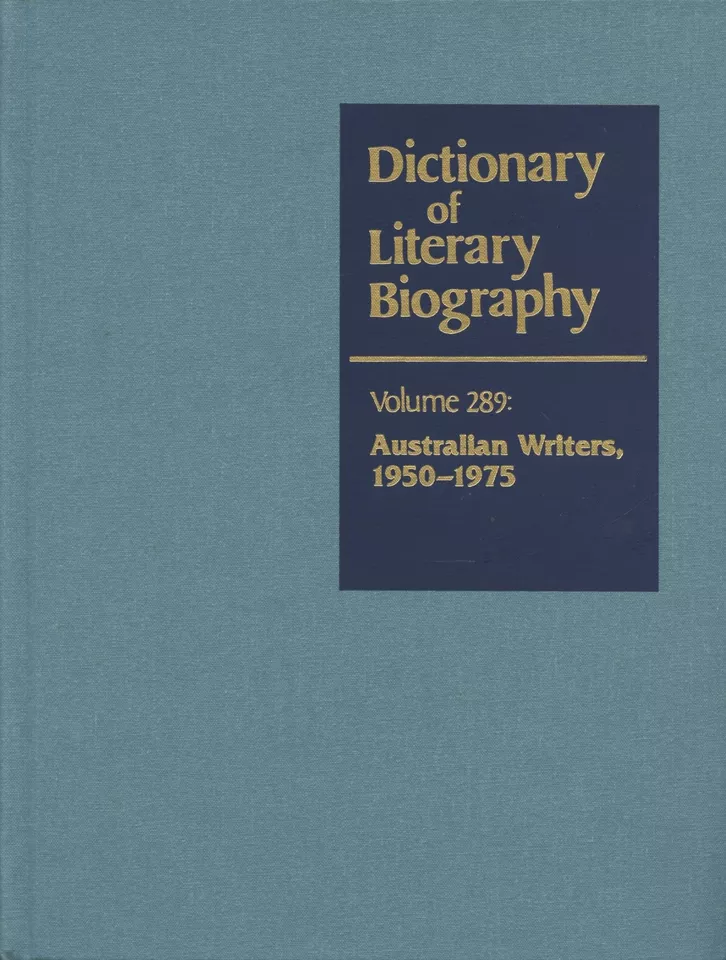- Free Article: No
- Contents Category: Reference
- Review Article: Yes
- Article Title: That Good Old Tyranny of Distance
- Online Only: No
- Custom Highlight Text:
This is the third volume in this US reference series that is dedicated to Australian writers. It includes writers who produced their first important book between 1950 and 1975. The Dictionary, which is held by all the major reference and research libraries around the world provides a welcome opportunity to display Australian writing in an international setting.
Forty writers are represented, from Robert Adamson to Patricia Wrightson. Each entry consists of a critical essay, a comprehensive bibliography of the author’s works, a select listing of the secondary literature and a note on the location of the author’s papers. There is also a portrait of each writer. The entries are written by Australians, many of whom have previously published on their subjects.
- Book 1 Title: Dictionary of Literary Biography Volume 289
- Book 1 Subtitle: Australian Writers, 1950-1975'
- Book 1 Biblio: Gale Group, US $270.50 hb, 462 pp
- Book 1 Cover Small (400 x 600):

- Book 1 Cover (800 x 1200):

There is inconsistency in the manner in which the essays have been approached. Those, for example, by Veronica Brady on Rodney Hall, Bruce Bennett on Dorothy Hewett, and Peter Alexander on Les Murray interweave the biography with an analysis of the works, so that the one illuminates the other. On the other hand, essays such as those by Anthony Hassall on Peter Carey, James Packer on David Ireland, and Peter Pierce on Thomas Keneally provide very little biographical information except as linking passages between literary criticism. This approach does not tell us much about the life or how the life intersects with the works.
All the essays, however, are engaging, informed and succinct. I think, though, that the former approach is what is expected from a Dictionary of Literary Biography. Clearer guidelines should have been provided to the contributors.
In my review of the previous two volumes (ABR, June/ July 2003), I was critical of the number of errors of fact. This is not the case in this volume. But there are irritating lapses, no doubt because the book was edited in the US. Dorothy Hewett was not elected to the Order of Australia (if election by knowledgeable voters were the mode, surely Peter Porter would not have recently been given only the Medal). There is no prize titled the New South Wales Premier Prize, just as there is no prize titled the Victorian Premier Prize. Why can’t the Yanks acknowledge that they don’t know everything and employ a good Australian copy editor?
I was also critical my earlier review of the number of omissions that impaired the volumes as works of reference. The editor acknowledged these omissions in her introduction and attributed them to ‘the usual problems of editorial selection and the more unexpected hindrances of scholarly fashion’. Woe betide an Australian writer who is not the scholarly fashion!
In this volume, there are omissions from the ranks of creative writers, such as Elizabeth Harrower, Joan Phipson, Ian Mudie and Brian James. However, they are not on the scale of the previous two volumes, and it would be churlish to cavil as none of us is perfect.
The advisory board for this dictionary defines literature as ‘the intellectual commerce of a nation’ and italicises this phrase presumably to make the point. The board writes that ‘DLB entries are not limited to “creative writers” but extend to other figures who in their time and in their way influenced the mind of a people. Thus the series encompasses historians, journalists, publishers, book collectors, and screenwriters.’ This has been ignored in the three Australian volumes that have been published to date, and it is a very serious shortcoming. In the period covered by the volume under review, a number of seminal books were published the authors of which are not included. These books ‘influenced the mind of a people’ and contributed to ‘the intellectual commerce of a nation’ far more than, for example, the popular novels of Morris West, who is accorded an entry.
A.A. Phillips’s The Australian Tradition (1958), Russel Ward’s The Australian Legend (1958), Bernard Smith’s European Vision and the South Pacific (1960), the first three volumes of Manning Clark’s A History of Australia (1962-73), Donald Home’s The Lucky Country (1964) and Geoffrey Blainey’s The Tyranny of Distance (1966) are major works, and most are still in print.
In her general overview of the period, the editor quotes both Phillips and Home. She also notes that Germaine Greer’s The Female Eunuch, which was published in 1970, was a ‘groundbreaking and highly influential critique’, yet Greer is not thought worthy of an entry, either. If Peter Porter, who has not lived in Australia since 1951, and Sumner Locke Elliott, who moved to America in 1948, are still considered Australian enough to be given an entry, why not Greer?
Ray Lawler has an entry. This is fitting, as Summer of the Seventeenth Doll is a pivotal play in the development of Australian drama. It was Australia’s own Look Back in Anger. However, the man who brought that play to prominence, Leslie Rees, and who also contributed greatly to the development of radio drama through his work at the ABC and, in addition, was a successful children’s writer, has been left out.
This volume fails as a work of reference, as do the other Australian volumes in this Dictionary of Literary Biography, not because of the quality of the individual entries. It fails because of the narrow criteria for inclusion, imposed seemingly by the Australian editor, which is at odds with the stated criteria of the editorial board. In this way, a golden opportunity to showcase Australian intellectual life on the world stage has been lost. Scholarly fashion rules. OK.


Comments powered by CComment